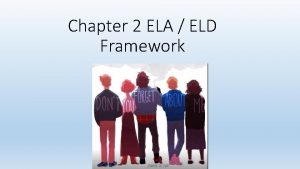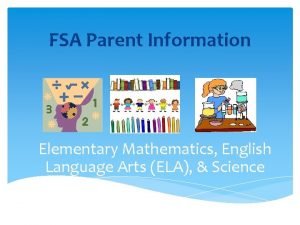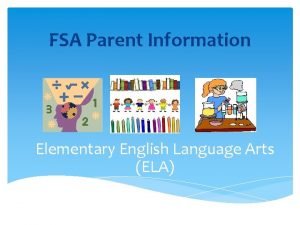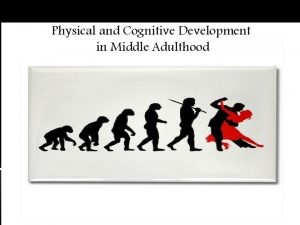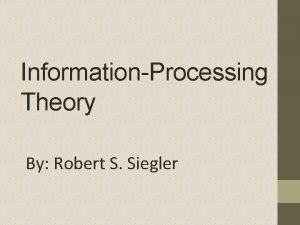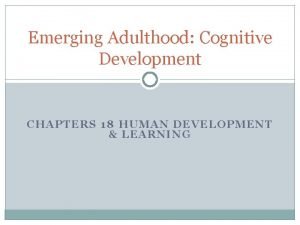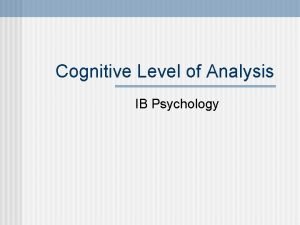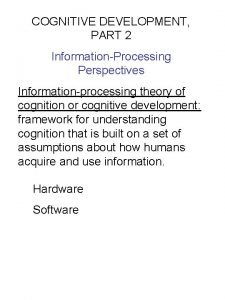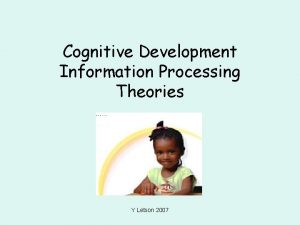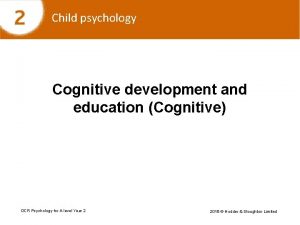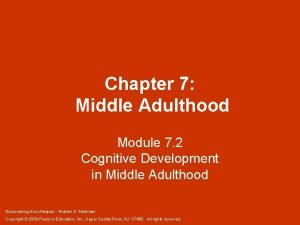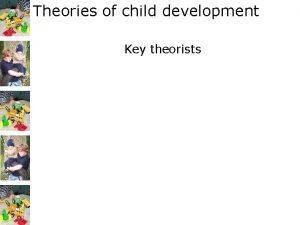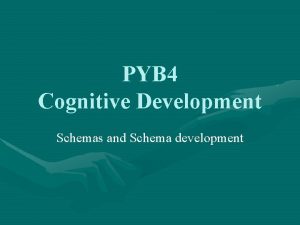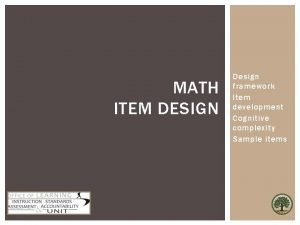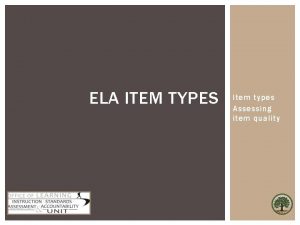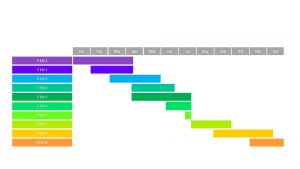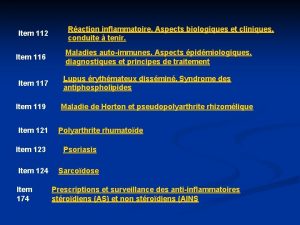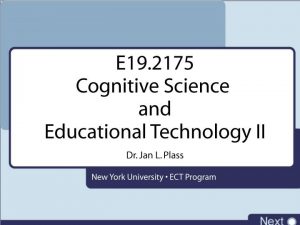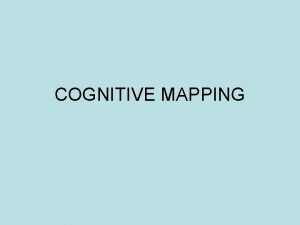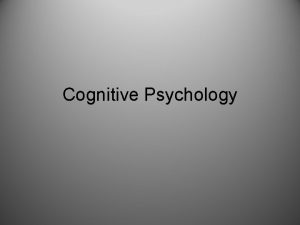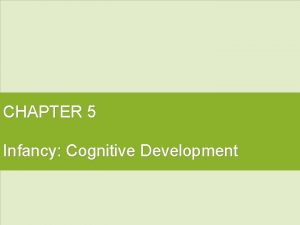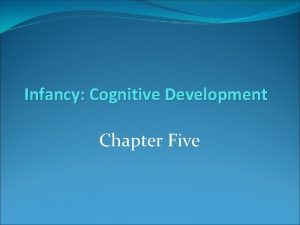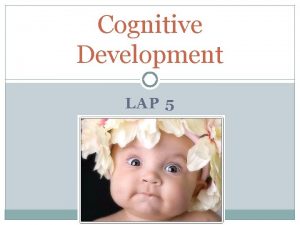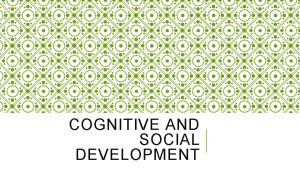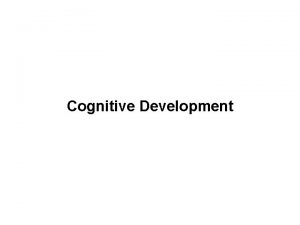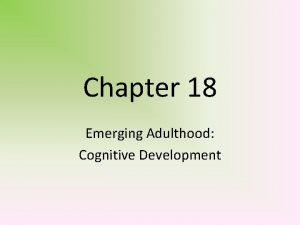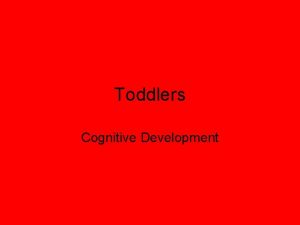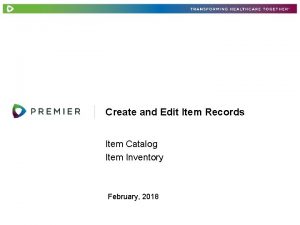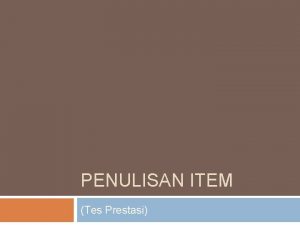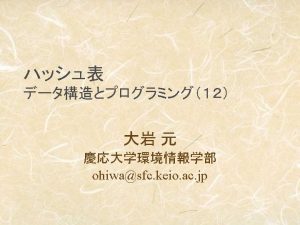ELA ITEM DESIGN Design framework Item development Cognitive






















- Slides: 22

ELA ITEM DESIGN Design framework Item development Cognitive complexity Sample items

4 BUILDING BLOCKS Learning Progression Item Design Assessment Quality Outcomes/ Scoring

ITEM DESIGN FRAMEWORK BEAR Assessment System Step 2 A match between what is taught and what is assessed Constructive alignment aligning teaching and assessment to the learning outcomes/standards (Biggs, 2003) Proposed items are located along the LP map One Framework (Wilson & Sloane, 2000) Teaching & Instruction Learning Outcomes/ Standards Assessment Task

ALIGNMENT FRAMEWORK Item design framework used by Smarter-Balanced Assessment under the evidence-centered design approach (Mislevy, Steinberg, & Almond, 2003) Defined as the degree to which expectations and assessments work together to improve and measure students learning

4 CRITERIA TO DETERMINE THE DEGREE OF ALIGNMENT 1. Categorical concurrence • Commonality between the content categories of the standards and those of the assessment items 2. Range of knowledge correspondence • Number of objectives within each standard covered by item(s) 3. Balance of representation • Relative coverage of content categories by items in a test 4. Depth of Knowledge consistency • Match between the cognitive demand of items and the level of cognitive demand communicated by the wording of the objectives

ITEM DEVELOPMENT Universal design § Design item that accurately assess the targeted competency for all students § Ensure item fairness – make sure that items are equally difficult for groups of equal ability (e. g. males and females; urban and rural) Vocabulary & language § use content-specific language appropriate to the assessed grade § For non-content-specific material, use vocabulary/language from previous grade levels

ITEM DEVELOPMENT Grade appropriateness § Design items that assess a primary content domain/standard of the appropriate grade § “For non-reading items, the reading level is approximately one grade level below the grade level of the test, except for specifically assessed content terms or concepts” (SBAC, 2012) Using items to link tests § For pre-post test designs, include some items that appeared on previous test(s) to measure student progress § If the time between tests is relatively long (i. e. 2 -3 months), the same test can be used § If the time is short (i. e. 2 -3 weeks), pick a few items to reuse and include new ones

COGNITIVE COMPLEXITY Use of Modified Bloom’s Taxonomy § Definition An example of Cognitive Rigor Matrix (Hess, et al. , 2009) Demonstration on how to align standards and proposed item(s) on the LP map

MODIFIED BLOOM’S TAXONOMY Modified by Anderson & Krathwohl (2001) Evaluation Synthesis Analysis Application Comprehension Knowledge Old Bloom’s Taxonomy (Bloom, 1956)

COGNITIVE RIGOR MATRIX

SAMPLE ITEMS FOCUS ON APPLICATION PROCESS Process Level 1: Recall & Reproduction Level 2: Skills & Concepts Level 3: Strategic Level 4: Thinking/ Extended Reasoning Thinking Apply: Carry out or use a procedure in a given situations; carry out (apply to a familiar task) or use (apply) to an unfamiliar task. Follow simple/routine procedures. Apply an algorithm or formula. Solve routine problems applying multiple concepts or decision points. Use or apply concepts to solve non-routine problems. Select or devise an approach among many alternatives to solve a novel problem.

SAMPLE ITEMS Intended levels: Grade 6, 7, 8 Intended Claim: Claim #1 § Students can read closely and analytically to comprehend a range of increasingly complex literary and informational texts. Strand: Reading Literary Text Anchor Domain: Craft & Structure Anchor Standards: § Interpret words and phrases as they are used in a text, including determining technical, connotative, and figurative meanings, and analyze how specific word choices shape meaning or tone. Standards: 8. RL. 4, 7. RL. 4, 6. RL. 4 Assessment Target: Target #7 on Language use

SAMPLE ITEMS’ SPECIFICATION DOK Grade 6 3 Grade 7 2 Grade 8 3 Determine the meaning of Grade-specific Standard: Determine the meaning of words and phrases as they are words and phrases as they RL-4 are used in a text, including figurative and connotative meanings; analyze the impact of a specific word choice on meaning and tone. used in a text, including figurative and connotative meanings; analyze the impact of rhymes and other repetitions of sounds (e. g. , alliteration) on a specific verse or stanza of a poem or section of a story or drama. Interpret impact or intent of Assessment Standards Interpret figurative language use (e. g. , for Target #7 – personification, metaphor), alliteration, onomatopoeia, Language Use literary devices, or imagery), literary devices (e. g. , connotative meanings of flashback, foreshadowing), or words and phrases used in connotative meanings of context and their impact words and phrases used in on reader interpretation context and their impact on reader interpretation are used in a text, including figurative and connotative meanings; analyze the impact of specific word choices on meaning and tone, including analogies or allusions to other texts. Determine or interpret impact or intent of figurative language/literary devices or connotative meanings of words and phrases used in context and the impact of those word choices on meaning and tone.

SAMPLE ITEM GRADE 8 Stimulus Text: Below is an excerpt from American Indian Stories. As you read the excerpt, consider how the author’s word choice develops certain aspects of the narrator’s experience and then answer the questions that follow. “The Legends” From American Indian Stories By Zitkala-Sa At the arrival of our guests I sat close to my mother, and did not leave her side without first asking her consent. I ate my supper in quiet, listening patiently to the talk of the old people, wishing all the time that they would begin the stories I loved best. At last, when I could not wait any longer, I whispered in my mother's ear, "Ask them to tell an Iktomi story, mother. " Soothing my impatience, my mother said aloud, "My little daughter is anxious to hear your legends. " By this time all were through eating, and the evening was fast deepening into twilight. As each in turn began to tell a legend, I pillowed my head in my mother's lap; and lying flat upon my back, I watched the stars as they peeped down upon me, one by one. The increasing interest of the tale aroused me, and I sat up eagerly listening to every word. The old women made funny remarks, and laughed so heartily that I could not help joining them. The distant howling of a pack of wolves or the hooting of an owl in the river bottom frightened me, and I nestled into my mother's lap. She added some dry sticks to the open fire, and the bright flames leaped up into the faces of the old folks as they sat around in a great circle.

SAMPLE ITEM GRADE 8, CONT’D LP Standard SBAC Standard 8. RL. 4. Determine the meaning of words and phrases as they are used in a text, including figurative and connotative meanings; analyze the impact of specific word choices on meaning and tone, including analogies or allusions to other texts. Determine or interpret impact or intent of figurative language/literary devices or connotative meanings of words and phrases used in context and the impact of those word choices on meaning and tone. Cognitive Rigor Analyze, Level 3 (Analyze author’s craft/concept)

SAMPLE ITEM GRADE 7 Stimulus text: This poem is spoken in the voice of a male mermaid, whose wife has decided to leave the ocean and return to life on land. The Forsaken Merman By Matthew Arnold Come, dear children, let us away; Down and away below! Now my brothers call from the bay, Now the great winds shoreward blow, Now the salt tides seaward flow; Now the wild white horses play, Champ and chafe and toss in the spray. Children dear, let us away! This way, this way! Call her once before you go— Call once yet! In a voice that she will know: "Margaret!" Children's voices should be dear (Call once more) to a mother's ear; Children's voices, wild with pain— Surely she will come again! Call her once and come away; This way, this way! "Mother dear, we cannot stay! The wild white horses foam and fret. " Margaret! Come, dear children, come away down; Call no more! One last look at the white-wall'd town And the little grey church on the windy shore, Then come down! She will not come though you call day; Come away, come away! Children dear, was it yesterday We heard the sweet bells over the bay? In the caverns where we lay, Through the surf and through the swell, The far-off sound of a silver bell? Sand-strewn caverns, cool and deep, Where the winds are all asleep; Where the spent lights quiver and gleam, Where the salt weed sways in the stream, Where the sea-beasts, ranged all round, Feed in the ooze of their pasture-ground; Where the se a-snakes coil and twine, Dry their mail and bask in the brine; Where great whales come sailing by, Sail and sail, with unshut eye, Round the world for ever and aye? When did music come this way? Children dear, was it yesterday?

SAMPLE ITEM GRADE 7, CONT’D

LP AND COGNITIVE RIGOR LP Standard 7. RL. 4. Determine the meaning of words and phrases as they are used in a text, including figurative and connotative meanings; analyze the impact of rhymes and other repetitions of sounds (e. g. , alliteration) on a specific verse or stanza of a poem or section of a story or drama. SBAC Standard Cognitive Rigor Interpret impact or intent of Analyze, Level 2 (Identify figurative language use (e. g. , use of literary devices) alliteration, onomatopoeia, imagery), literary devices (e. g. , flashback, foreshadowing), or connotative meanings of words and phrases used in context and their impact on reader interpretation

SAMPLE ITEM GRADE 6 The highlighted sentence from Summer on Wheels includes a literary device • What does the literary device mean? • Why did the author most likely select the literary device for this description? Write a 2 -3 sentence answer responding to these questions

LP AND COGNITIVE RIGOR LP Standard 6. RL. 4. Determine the meaning of words and phrases as they are used in a text, including figurative and connotative meanings; analyze the impact of a specific word choice on meaning and tone. SBAC Standard Cognitive Rigor Interpret figurative language Analyze, Level 3 (Analyze use (e. g. , personification, author’s craft, viewpoint, metaphor), literary devices, or or potential bias) connotative meanings of words and phrases used in context and their impact on reader interpretation.

BIBLIOGRAPHY Bloom, B. S. (1956). Taxonomy of educational objectives. Handbook I: The Cognitive Domain. New York, NY: David Mc. Kay Co. Anderson, L. W. , & Krathwohl, D. (2001). A Taxonomy for Learning, Teaching, and Assessing: A Revision of Bloom's Taxonomy of Educational Objectives. New York, NY: Longman. Common Core Standards Initiative. (2014). Common core standards for English language arts & literacy in history/social studies, science, and technical subjects. Retrieved from http: //www. corestandards. org/ELA-Literacy / Hess, K. , Carloc, D. , Jones, B. , & Walkup, J. , (2009). What exactly do “fewer, clearer, and higher standards” really look like in the classroom? Using a cognitive rigor matrix to analyze curriculum, plan lessons, and implement assessments. Paper presented at CCSSO, Detroit, Michigan. Nitko, A. J. , & Brookhart, S. (2007). Educational assessment of students. Upper Saddle River, NJ: Pearson Education, Inc. Mc. Millan, J. H. (2007). Classroom assessment. Principles and practice for effective standard-based instruction (4 th ed. ). Boston: Pearson - Allyn & Bacon. Oregon Department of Education. (2014, June). Assessment guidance. (2014). CCSS Toolkit: ELA/Literacy Claim 1 Sample Summative Items ( 6 -8). Retrieved from http: //www. ode. state. or. us/search/page/? id=3714 Webb, N. (2007). Aligning assessments and standards. Retrieved from http: //www. wcer. wisc. edu/news/cover. Stories/aligning_assessments_and_standards. php Wilson, M. (2005). Constructing measures: An item response modeling approach. New York, NY: Psychology Press, Taylor & Francis Group. Wilson, M. , & Sloane, K. (2000). From principles to practice: An embedded assessment system. Applied Measurement in Education, 13 (2), pp. 181 -208. Smarter Balanced Assessment Consortium. (2012, April). General item specifications. CCSS

CREATIVE COMMONS LICENSE Item Design (ELA) PPT by the Oregon Department of Education and Berkeley Evaluation and Assessment Research Center is licensed under a CC BY 4. 0. You are free to: Share — copy and redistribute the material in any medium or format Adapt — remix, transform, and build upon the material Under the following terms: Attribution — You must give appropriate credit, provide a link to the license, and indicate if changes were made. You may do so in any reasonable manner, but not in any way that suggests the licensor endorses you or your use. Non. Commercial — You may not use the material for commercial purposes. Share. Alike — If you remix, transform, or build upon the material, you must distribute your contributions under the same license as the original. Oregon Department of Education welcomes editing of these resources and would greatly appreciate being able to learn from the changes made. To share an edited version of this resource, please contact Cristen Mc. Lean, cristen. mclean@state. or. us.
 Cognitive and non cognitive religious language
Cognitive and non cognitive religious language Ela/eld framework
Ela/eld framework Item-item yang berkaitan ditampilkan bersama
Item-item yang berkaitan ditampilkan bersama Fsa test design summary
Fsa test design summary Fsa ela test design summary 2021
Fsa ela test design summary 2021 Fsa test design summary 2020
Fsa test design summary 2020 Cognitive development in middle adulthood
Cognitive development in middle adulthood Cognitive development early adulthood
Cognitive development early adulthood Middle and late childhood
Middle and late childhood Module 47 infancy and childhood cognitive development
Module 47 infancy and childhood cognitive development Intellectual development in older adulthood
Intellectual development in older adulthood Gerome bruner
Gerome bruner Information processing theory child development
Information processing theory child development Postformal thought
Postformal thought Cognitive levels of development
Cognitive levels of development Intellectual development characteristics
Intellectual development characteristics Piaget information processing theory
Piaget information processing theory Information processing theory of cognitive development
Information processing theory of cognitive development Education cognitive development
Education cognitive development Cognitive development in middle adulthood
Cognitive development in middle adulthood Physical development in adulthood
Physical development in adulthood Bandura theory
Bandura theory Schema cognitive development
Schema cognitive development

